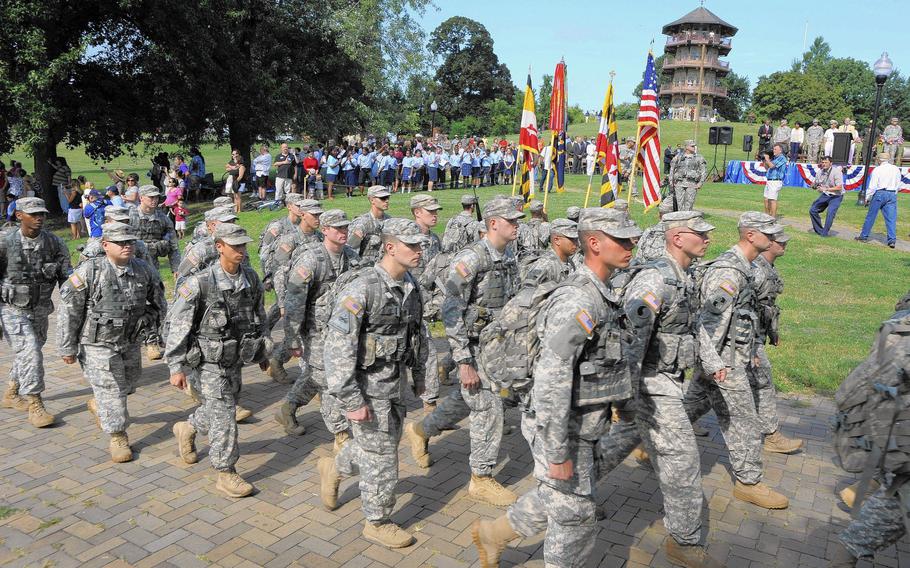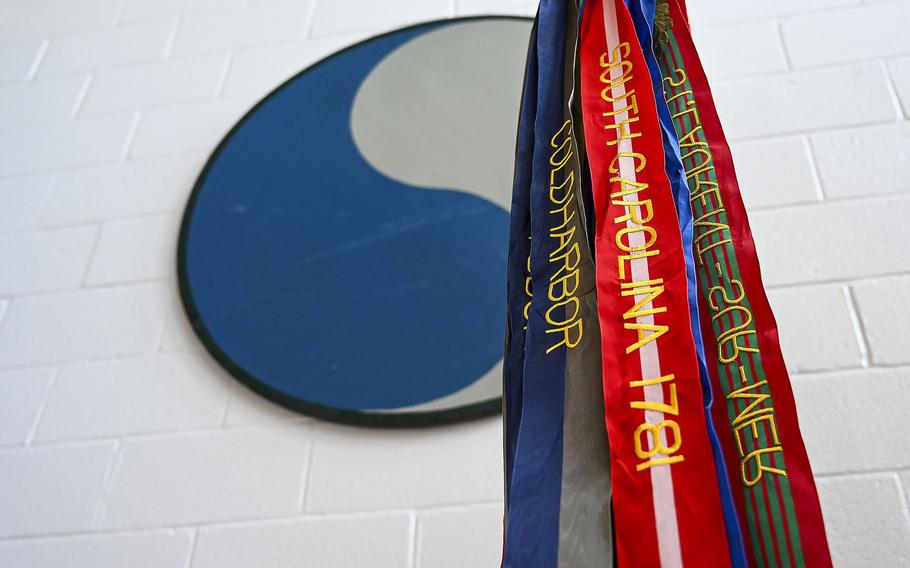
Streamers are displayed atop a flag as soldiers of the Maryland Army National Guard's 175th Infantry Regiment march. (Lloyd Fox, Baltimore Sun/TNS)
(Tribune News Service) — Few units in the U.S. Army are as fabled as the Dundalk-based 1st Battalion, 175th Infantry Regiment (5th Maryland), better known simply as the 175th Infantry Regiment, of the Maryland Army National Guard.
Formed as the Baltimore Independent Cadets in 1774, the unit helped save George Washington’s army at the Battle of Brooklyn in 1776, played a major role in saving Baltimore from British destruction at the Battle of North Point in 1814, hit Omaha Beach on June 7, 1944, and took part in the U.S. war on terror in the mid-2000s. Today, it’s a force of about 600 citizen-soldiers, with armories in Dundalk, Easton, Glen Burnie, Frederick and Silver Spring.
What’s little known today, however, is that many members of the unit split from the Union during the Civil War and took up arms for the South. Historians say most of its foot soldiers — largely working-class Baltimoreans who were, at best, suspicious of the intentions of President Abraham Lincoln — left for Virginia, where they reformed as the 1st Maryland Infantry Regiment (Confederate).
Enough of the outfit did so that the 175th gives their exploits a place of honor in unit history.
But a national Naming Commission tasked with reconsidering Confederate ties among the names of U.S. military installations and symbols is on the verge of changing that.
Like many units in the U.S. military, the 175th carries streamers, or commemorative military banners, atop its flag. They resemble long, colorful ribbons, each with lettering that names a campaign or battle in which the unit took part. People can see them on display in parades and color guard exercises. Seven of the unit’s more than two dozen streamers have blue and gray stripes and bear the name of a Civil War battle or campaign in which its soldiers fought on the Southern side.
The chair of the national panel, retired Navy Admiral Michelle J. Howard, has notified the House and Senate armed services committees that the panel will recommend the Army eliminate a 1949 rule that gave U.S. military units permission to fly streamers symbolic of battles in which they fought for the Southern side. The commission released her letter publicly Aug. 1.
“Forty-eight Army units have at least one Confederate campaign streamer; a total of 457 Confederate streamers are presently authorized,” Howard wrote. As a result of the recommendation, “those 457 Confederate battle streamers would no longer be authorized.” The units are spread across 11 Southern states, plus Missouri, with Georgia and Virginia having by far the most units that would be affected.

A national Naming Commission is recommending that seven battle streamers associated with the Maryland Army National Guard’s 175th Infantry Division be removed because they are associated with the Confederacy. The streamers are shown in Frederick. (Kevin Richardson, Baltimore Sun/TNS)
All indications are that the entities involved, the congressional committees and Secretary of Defense Lloyd Austin, will accept the committee’s recommendation. That would mean the streamers would be removed from service as early as next year.
If Austin approves the change, the Army’s Center for Military History and its subunit, the Army Institute of Heraldry, “would take those recommendations and push out guidance for changes, and we would adhere to them,” said Capt. Ben Hughes, a spokesman for the Maryland National Guard. “If they say, ‘Take those streamers off,’ those streamers would come off.”
The Naming Commission, a panel consisting of former uniformed and civilian military leaders, was established as part of the National Defense Authorization Act of 2021. Its charge is to submit a final report to Congress by Oct. 1 with recommendations to remove, rename or modify “names, symbols, displays, monuments and paraphernalia within the Department of Defense that commemorate the Confederacy.”
The commission was formed in the wake of the police killing of George Floyd in Minnesota in 2020 and the national reckoning on race that followed.
Its most widely known assignment has been to reconsider the names of bases that honor Confederate officers. The panel has recommended new names for nine installations.
Commissioners are also scrutinizing the names of scores of streets, buildings, ships and fields, as well as signs, statues and memorials. An additional category under review is heraldry — the symbols and images military units use in branding and in encapsulating their history. Last week, Howard announced that the group would recommend that the 29th Infantry Division, another storied Army component with Maryland ties, be allowed to retain its blue-and-gray, yin-yang style insignia.
The streamers are another form of heraldry. The Army confers the ribbons on fighting units to commemorate significant battles in which they have taken part. Made of silk or nylon, they’re typically affixed to a unit’s regimental flag. When that flag is displayed or unfurled — whether at a ceremony or in the field — the streamers provide a visual representation of a unit’s achievements.
The 175th’s total of 31 is extraordinary, owing to its long and active combat history. At 248 years old, it’s the oldest continuously operating military unit in Maryland, said Joe Balkoski, a military historian and author, and one of the oldest in the U.S. armed forces.
Seven symbolize the participation of the 1st Maryland in engagements on behalf of the Confederacy. Civil War streamers are designed in blue and gray, with the color of the side the unit fought for on top and the name of the battle or campaign spelled out. The regiment’s seven represent its participation at First Manassas (called the First Battle of Bull Run by the North), the Peninsula campaign, the Shenandoah Valley campaign, and the battles of Gettysburg, Cold Harbor, Petersburg and Appomattox.
Balkoski said the Army developed the streamer system to build esprit de corps.
“The entire purpose is to, at a glance, have soldiers understand that over many centuries, soldiers of the very unit that they’re in participated in this conflict, performed this valorous service, and had a strong morale based on the bonding of military units at this level,” he said.
The regiment’s honorary colonel and longtime member, retired Army Col. Randy Everett, along with the unit’s leadership, consider Confederate ideology to have been hurtful and offensive. But Everett said he considers it regrettable to lose nearly one-fourth of the unit’s streamers because it takes a bite out of its historical representation.
They’re an “amalgamation of the history of a unit that dates back to before the founding of the republic,” said Everett, from the prewar Colonial days through the War on Terror.
“I would not in any way want to offend anyone or cause consternation, but the history of the 175th does transcend our nation. And even during those Civil War years, that history did take place,” he said. “In my view, history is there to be learned from, and in that way, I’m sorry we’ll probably be losing a piece of it.”
The congressional committees will convey their thinking to Austin when the time comes, and the military boss will make the final call, If, as most expect, he backs the change, Everett said he’ll do what a good soldier always does: salute and support the decision.
“In the end, we follow our orders,” he said.
©2022 Baltimore Sun.
Visit baltimoresun.com.
Distributed by Tribune Content Agency, LLC.